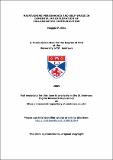Files in this item
Maintaining personhood and self-image in dementia : an exploration of collaborative communication
Item metadata
| dc.contributor.advisor | Astell, Arlene Jean | |
| dc.contributor.author | Ellis, Maggie P. | |
| dc.coverage.spatial | xvii, 277 p. | en_US |
| dc.date.accessioned | 2010-01-12T12:37:07Z | |
| dc.date.available | 2010-01-12T12:37:07Z | |
| dc.date.issued | 2009 | |
| dc.identifier.uri | https://hdl.handle.net/10023/844 | |
| dc.description.abstract | The main aim of this thesis was to explore the maintenance of personhood and self-image in dementia by way of facilitating collaborative communication between people with dementia and their caregivers/interaction partners. As such, the roles of the person with dementia and the interaction partner were examined in each study within the realms of the ‘Collaborative Personhood Model’. Findings of the first study highlighted strategies used by people with mild to severe dementia to maintain social interactions, to save-face and to maintain and project a sense of self-image in a reminiscence situation. The impact of introducing a family member as the interaction partner in a similar reminiscence-based situation using personal photographs was then explored. The findings of this study indicated that the personal nature of the photographs can create conflict between the person with dementia and her family member. Crucially, these studies illuminated the supportive role that the communication partner must adopt in order to successfully facilitate people with dementia to maximise their retained communication skills. Communication and sense of self was then examined in an individual with very severe dementia with some retained speech. The findings of this study illuminated the potential of imitation in communicating with people at this stage of the illness. These findings were then built upon by exploring the use of Intensive Interaction (II) in a person with very advanced dementia with no retained speech. Findings of this study indicated retained awareness of self and functional communication skills at very late stages of dementia. Finally, this study was expanded using a modified version of II (Adaptive Interaction) in a small group of individuals with very severe dementia with very little or no retained speech. These findings indicated an unprecedented desire and ability to communicate in people with such severe dementia. Taken as a whole, these studies highlighted the adaptive and collaborative role that the interaction partner must adopt in order to facilitate the maintenance of personhood and self-image in people with dementia. More specifically, the interaction partner must adjust to the communicative repertoire that is maintained at each stage of dementia and in each individual. The ‘Collaborative Personhood Model’ represents an attempt to explain how this might be achieved. | en_US |
| dc.language.iso | en | en_US |
| dc.publisher | University of St Andrews | |
| dc.subject.lcc | RC521.E6 | |
| dc.subject.lcsh | Dementia--Patients--Psychology | en |
| dc.subject.lcsh | People with mental disabilities--Means of communication | en |
| dc.subject.lcsh | Social interaction--Psychological aspects | en |
| dc.title | Maintaining personhood and self-image in dementia : an exploration of collaborative communication | en_US |
| dc.type | Thesis | en_US |
| dc.type.qualificationlevel | Doctoral | en_US |
| dc.type.qualificationname | PhD Doctor of Philosophy | en_US |
| dc.publisher.institution | The University of St Andrews | en_US |
This item appears in the following Collection(s)
Items in the St Andrews Research Repository are protected by copyright, with all rights reserved, unless otherwise indicated.

